Project Report: Finance for Managers - Capital Structure and Budgeting
VerifiedAdded on 2021/04/21
|12
|2987
|20
Report
AI Summary
This project report provides a comprehensive analysis of capital structure and dividend policy, focusing on JB HI FI's financial strategies. It examines the company's debt-to-equity ratio, dividend payout practices, and their impact on shareholder value. The report also includes a capital budgeting analysis, evaluating an investment opportunity using techniques such as Net Present Value (NPV), Internal Rate of Return (IRR), and payback period. The analysis demonstrates the profitability of the investment, offering insights into the company's financial performance and decision-making processes. The report concludes with recommendations based on the financial analysis.
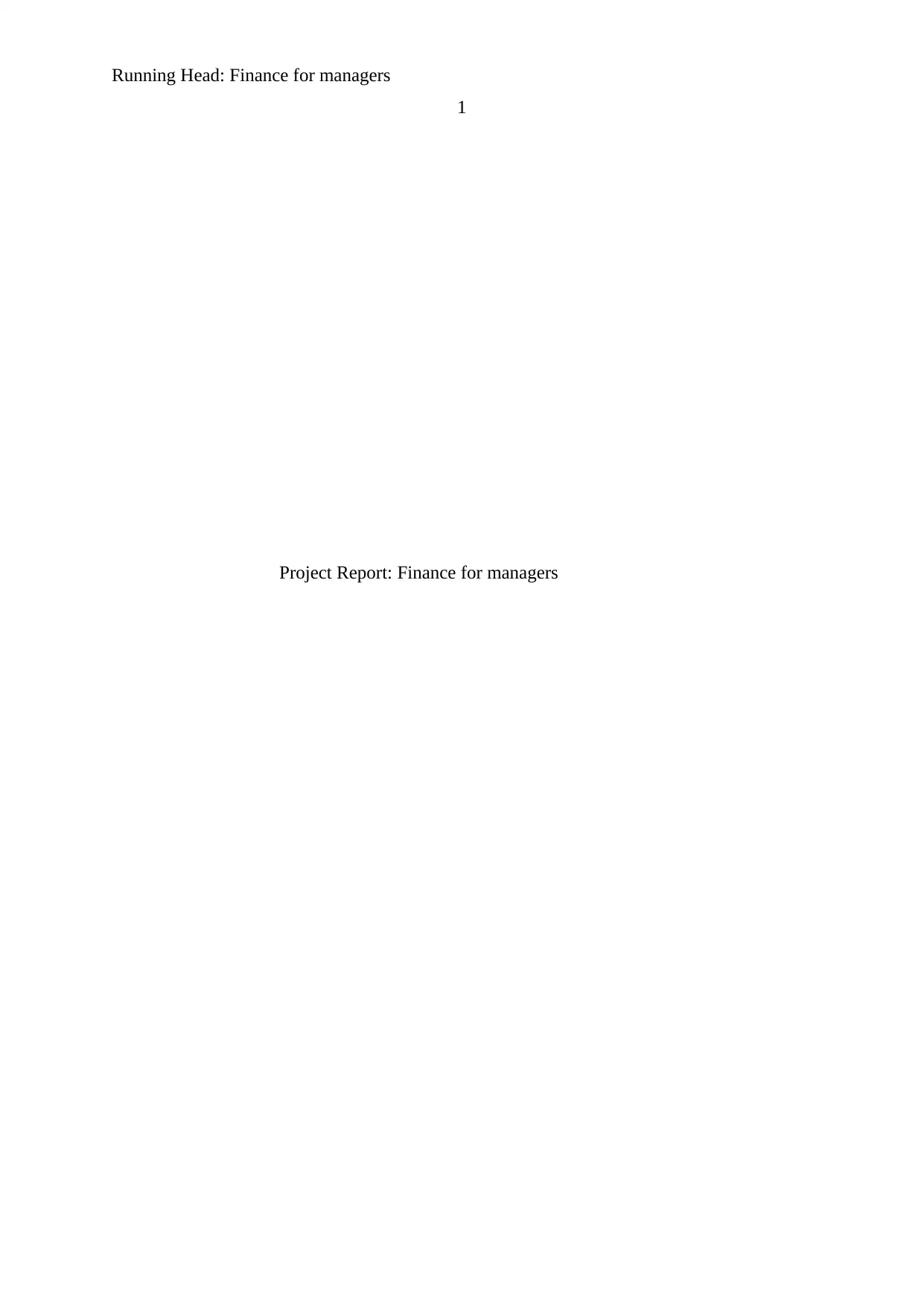
Running Head: Finance for managers
1
Project Report: Finance for managers
1
Project Report: Finance for managers
Paraphrase This Document
Need a fresh take? Get an instant paraphrase of this document with our AI Paraphraser
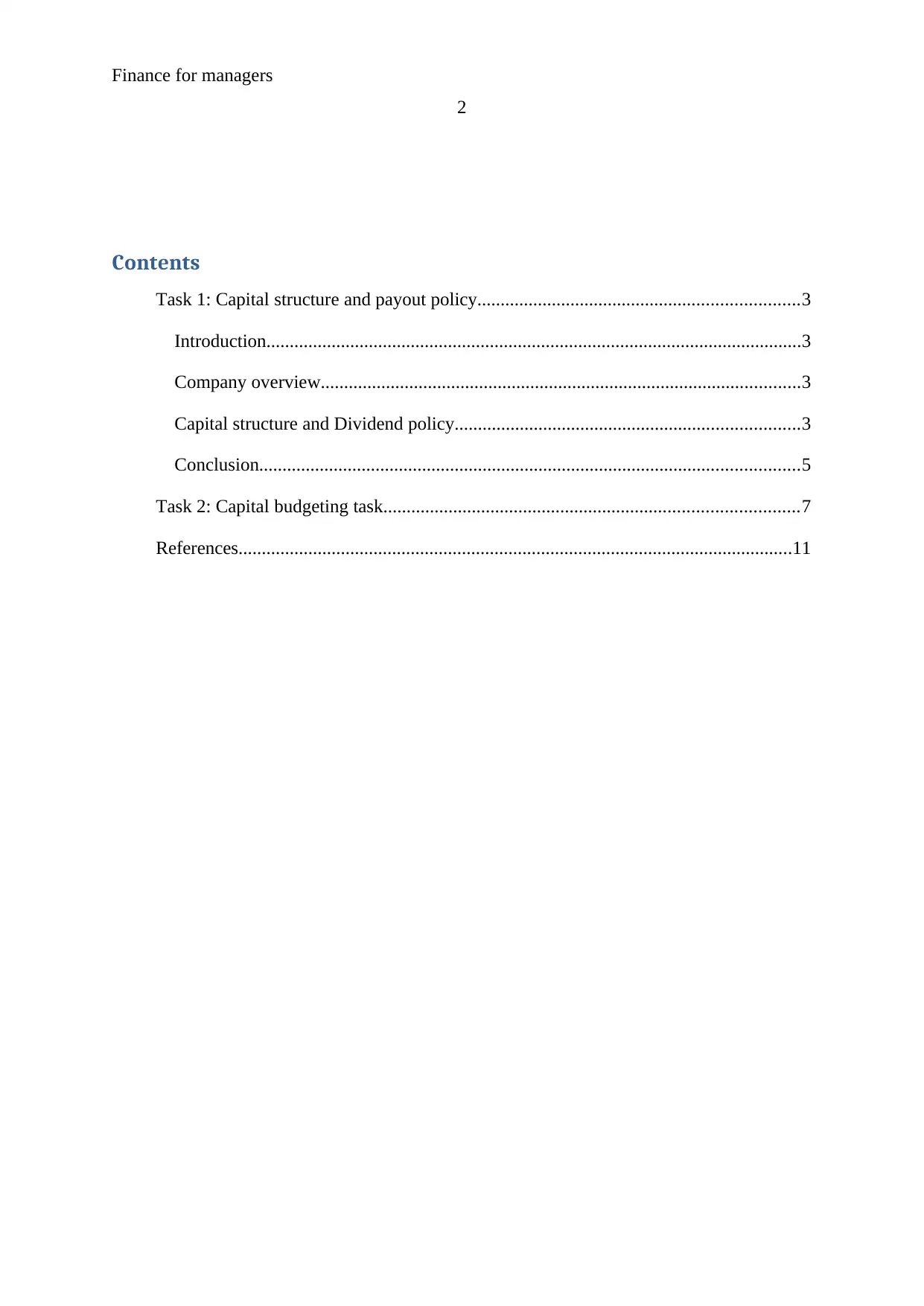
Finance for managers
2
Contents
Task 1: Capital structure and payout policy.....................................................................3
Introduction...................................................................................................................3
Company overview.......................................................................................................3
Capital structure and Dividend policy..........................................................................3
Conclusion....................................................................................................................5
Task 2: Capital budgeting task.........................................................................................7
References.......................................................................................................................11
2
Contents
Task 1: Capital structure and payout policy.....................................................................3
Introduction...................................................................................................................3
Company overview.......................................................................................................3
Capital structure and Dividend policy..........................................................................3
Conclusion....................................................................................................................5
Task 2: Capital budgeting task.........................................................................................7
References.......................................................................................................................11
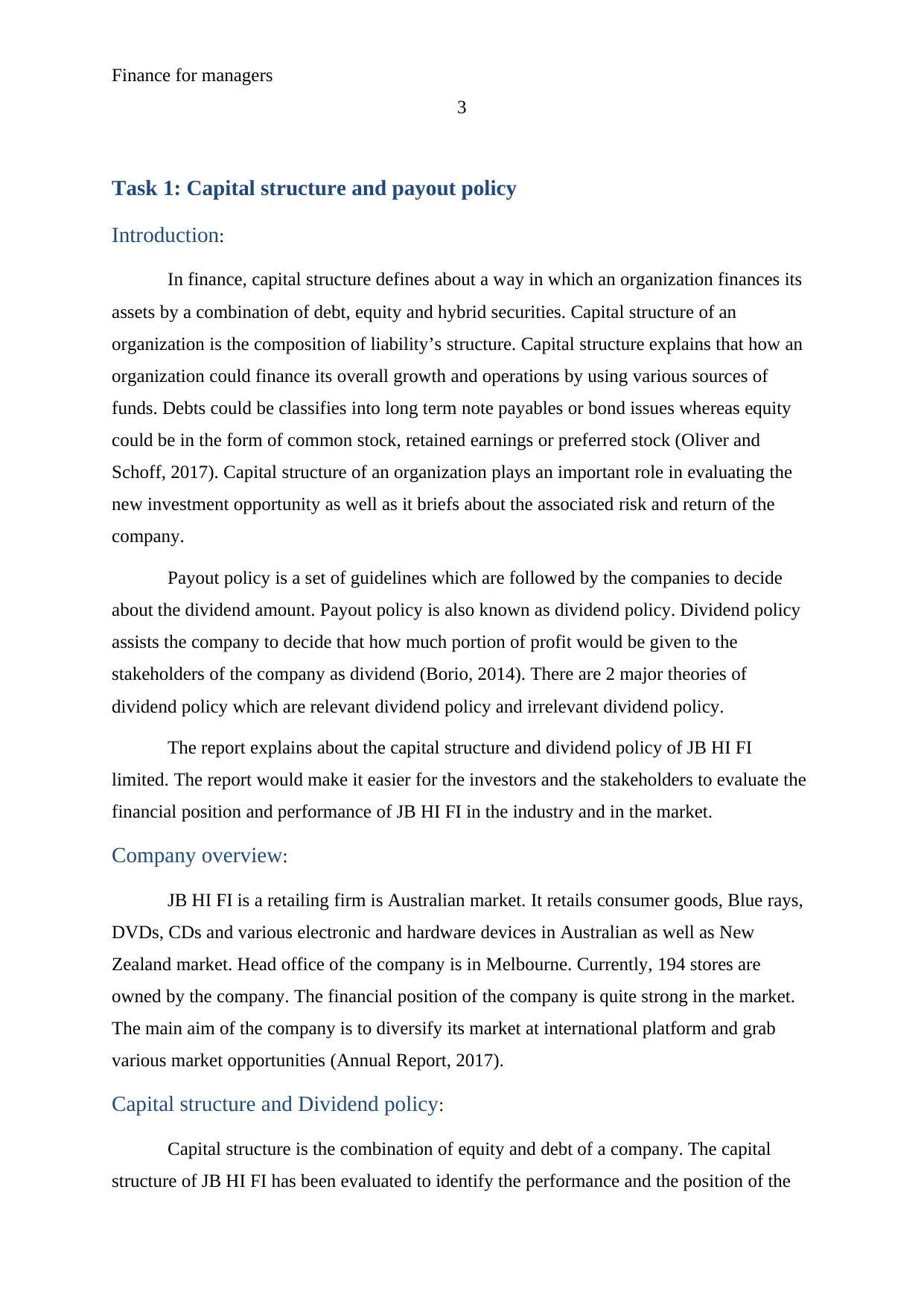
Finance for managers
3
Task 1: Capital structure and payout policy
Introduction:
In finance, capital structure defines about a way in which an organization finances its
assets by a combination of debt, equity and hybrid securities. Capital structure of an
organization is the composition of liability’s structure. Capital structure explains that how an
organization could finance its overall growth and operations by using various sources of
funds. Debts could be classifies into long term note payables or bond issues whereas equity
could be in the form of common stock, retained earnings or preferred stock (Oliver and
Schoff, 2017). Capital structure of an organization plays an important role in evaluating the
new investment opportunity as well as it briefs about the associated risk and return of the
company.
Payout policy is a set of guidelines which are followed by the companies to decide
about the dividend amount. Payout policy is also known as dividend policy. Dividend policy
assists the company to decide that how much portion of profit would be given to the
stakeholders of the company as dividend (Borio, 2014). There are 2 major theories of
dividend policy which are relevant dividend policy and irrelevant dividend policy.
The report explains about the capital structure and dividend policy of JB HI FI
limited. The report would make it easier for the investors and the stakeholders to evaluate the
financial position and performance of JB HI FI in the industry and in the market.
Company overview:
JB HI FI is a retailing firm is Australian market. It retails consumer goods, Blue rays,
DVDs, CDs and various electronic and hardware devices in Australian as well as New
Zealand market. Head office of the company is in Melbourne. Currently, 194 stores are
owned by the company. The financial position of the company is quite strong in the market.
The main aim of the company is to diversify its market at international platform and grab
various market opportunities (Annual Report, 2017).
Capital structure and Dividend policy:
Capital structure is the combination of equity and debt of a company. The capital
structure of JB HI FI has been evaluated to identify the performance and the position of the
3
Task 1: Capital structure and payout policy
Introduction:
In finance, capital structure defines about a way in which an organization finances its
assets by a combination of debt, equity and hybrid securities. Capital structure of an
organization is the composition of liability’s structure. Capital structure explains that how an
organization could finance its overall growth and operations by using various sources of
funds. Debts could be classifies into long term note payables or bond issues whereas equity
could be in the form of common stock, retained earnings or preferred stock (Oliver and
Schoff, 2017). Capital structure of an organization plays an important role in evaluating the
new investment opportunity as well as it briefs about the associated risk and return of the
company.
Payout policy is a set of guidelines which are followed by the companies to decide
about the dividend amount. Payout policy is also known as dividend policy. Dividend policy
assists the company to decide that how much portion of profit would be given to the
stakeholders of the company as dividend (Borio, 2014). There are 2 major theories of
dividend policy which are relevant dividend policy and irrelevant dividend policy.
The report explains about the capital structure and dividend policy of JB HI FI
limited. The report would make it easier for the investors and the stakeholders to evaluate the
financial position and performance of JB HI FI in the industry and in the market.
Company overview:
JB HI FI is a retailing firm is Australian market. It retails consumer goods, Blue rays,
DVDs, CDs and various electronic and hardware devices in Australian as well as New
Zealand market. Head office of the company is in Melbourne. Currently, 194 stores are
owned by the company. The financial position of the company is quite strong in the market.
The main aim of the company is to diversify its market at international platform and grab
various market opportunities (Annual Report, 2017).
Capital structure and Dividend policy:
Capital structure is the combination of equity and debt of a company. The capital
structure of JB HI FI has been evaluated to identify the performance and the position of the
⊘ This is a preview!⊘
Do you want full access?
Subscribe today to unlock all pages.

Trusted by 1+ million students worldwide
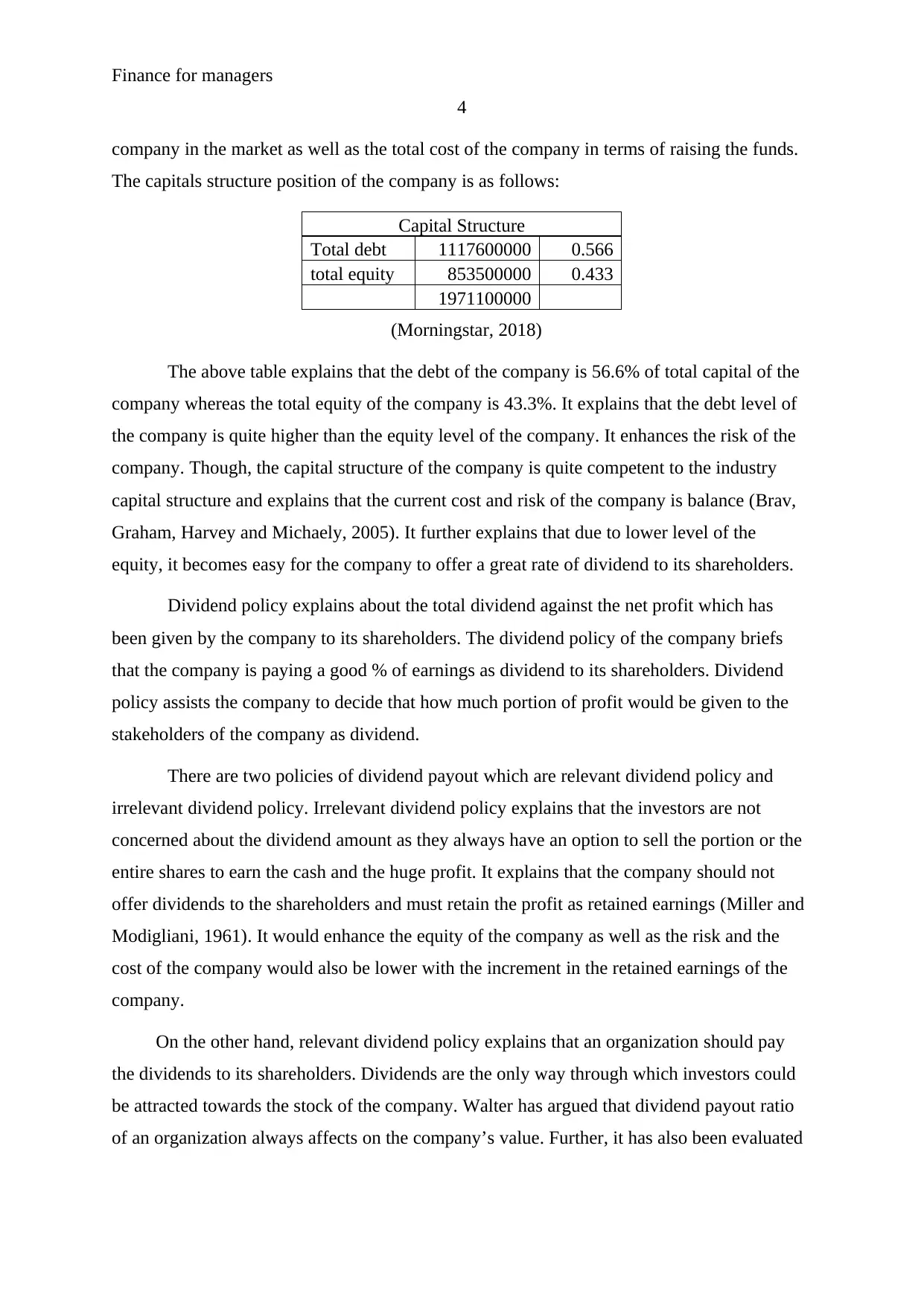
Finance for managers
4
company in the market as well as the total cost of the company in terms of raising the funds.
The capitals structure position of the company is as follows:
Capital Structure
Total debt 1117600000 0.566
total equity 853500000 0.433
1971100000
(Morningstar, 2018)
The above table explains that the debt of the company is 56.6% of total capital of the
company whereas the total equity of the company is 43.3%. It explains that the debt level of
the company is quite higher than the equity level of the company. It enhances the risk of the
company. Though, the capital structure of the company is quite competent to the industry
capital structure and explains that the current cost and risk of the company is balance (Brav,
Graham, Harvey and Michaely, 2005). It further explains that due to lower level of the
equity, it becomes easy for the company to offer a great rate of dividend to its shareholders.
Dividend policy explains about the total dividend against the net profit which has
been given by the company to its shareholders. The dividend policy of the company briefs
that the company is paying a good % of earnings as dividend to its shareholders. Dividend
policy assists the company to decide that how much portion of profit would be given to the
stakeholders of the company as dividend.
There are two policies of dividend payout which are relevant dividend policy and
irrelevant dividend policy. Irrelevant dividend policy explains that the investors are not
concerned about the dividend amount as they always have an option to sell the portion or the
entire shares to earn the cash and the huge profit. It explains that the company should not
offer dividends to the shareholders and must retain the profit as retained earnings (Miller and
Modigliani, 1961). It would enhance the equity of the company as well as the risk and the
cost of the company would also be lower with the increment in the retained earnings of the
company.
On the other hand, relevant dividend policy explains that an organization should pay
the dividends to its shareholders. Dividends are the only way through which investors could
be attracted towards the stock of the company. Walter has argued that dividend payout ratio
of an organization always affects on the company’s value. Further, it has also been evaluated
4
company in the market as well as the total cost of the company in terms of raising the funds.
The capitals structure position of the company is as follows:
Capital Structure
Total debt 1117600000 0.566
total equity 853500000 0.433
1971100000
(Morningstar, 2018)
The above table explains that the debt of the company is 56.6% of total capital of the
company whereas the total equity of the company is 43.3%. It explains that the debt level of
the company is quite higher than the equity level of the company. It enhances the risk of the
company. Though, the capital structure of the company is quite competent to the industry
capital structure and explains that the current cost and risk of the company is balance (Brav,
Graham, Harvey and Michaely, 2005). It further explains that due to lower level of the
equity, it becomes easy for the company to offer a great rate of dividend to its shareholders.
Dividend policy explains about the total dividend against the net profit which has
been given by the company to its shareholders. The dividend policy of the company briefs
that the company is paying a good % of earnings as dividend to its shareholders. Dividend
policy assists the company to decide that how much portion of profit would be given to the
stakeholders of the company as dividend.
There are two policies of dividend payout which are relevant dividend policy and
irrelevant dividend policy. Irrelevant dividend policy explains that the investors are not
concerned about the dividend amount as they always have an option to sell the portion or the
entire shares to earn the cash and the huge profit. It explains that the company should not
offer dividends to the shareholders and must retain the profit as retained earnings (Miller and
Modigliani, 1961). It would enhance the equity of the company as well as the risk and the
cost of the company would also be lower with the increment in the retained earnings of the
company.
On the other hand, relevant dividend policy explains that an organization should pay
the dividends to its shareholders. Dividends are the only way through which investors could
be attracted towards the stock of the company. Walter has argued that dividend payout ratio
of an organization always affects on the company’s value. Further, it has also been evaluated
Paraphrase This Document
Need a fresh take? Get an instant paraphrase of this document with our AI Paraphraser
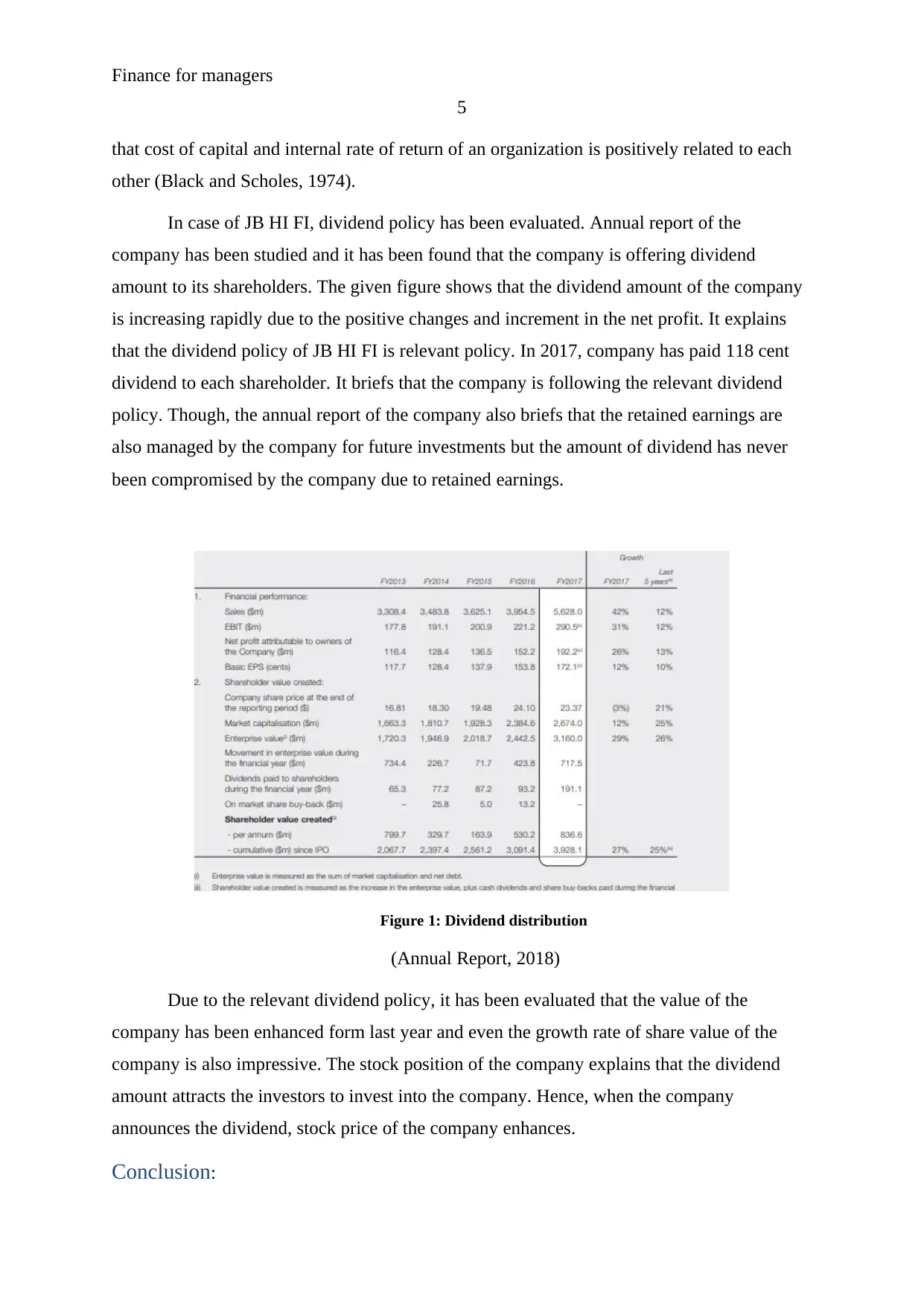
Finance for managers
5
that cost of capital and internal rate of return of an organization is positively related to each
other (Black and Scholes, 1974).
In case of JB HI FI, dividend policy has been evaluated. Annual report of the
company has been studied and it has been found that the company is offering dividend
amount to its shareholders. The given figure shows that the dividend amount of the company
is increasing rapidly due to the positive changes and increment in the net profit. It explains
that the dividend policy of JB HI FI is relevant policy. In 2017, company has paid 118 cent
dividend to each shareholder. It briefs that the company is following the relevant dividend
policy. Though, the annual report of the company also briefs that the retained earnings are
also managed by the company for future investments but the amount of dividend has never
been compromised by the company due to retained earnings.
Figure 1: Dividend distribution
(Annual Report, 2018)
Due to the relevant dividend policy, it has been evaluated that the value of the
company has been enhanced form last year and even the growth rate of share value of the
company is also impressive. The stock position of the company explains that the dividend
amount attracts the investors to invest into the company. Hence, when the company
announces the dividend, stock price of the company enhances.
Conclusion:
5
that cost of capital and internal rate of return of an organization is positively related to each
other (Black and Scholes, 1974).
In case of JB HI FI, dividend policy has been evaluated. Annual report of the
company has been studied and it has been found that the company is offering dividend
amount to its shareholders. The given figure shows that the dividend amount of the company
is increasing rapidly due to the positive changes and increment in the net profit. It explains
that the dividend policy of JB HI FI is relevant policy. In 2017, company has paid 118 cent
dividend to each shareholder. It briefs that the company is following the relevant dividend
policy. Though, the annual report of the company also briefs that the retained earnings are
also managed by the company for future investments but the amount of dividend has never
been compromised by the company due to retained earnings.
Figure 1: Dividend distribution
(Annual Report, 2018)
Due to the relevant dividend policy, it has been evaluated that the value of the
company has been enhanced form last year and even the growth rate of share value of the
company is also impressive. The stock position of the company explains that the dividend
amount attracts the investors to invest into the company. Hence, when the company
announces the dividend, stock price of the company enhances.
Conclusion:
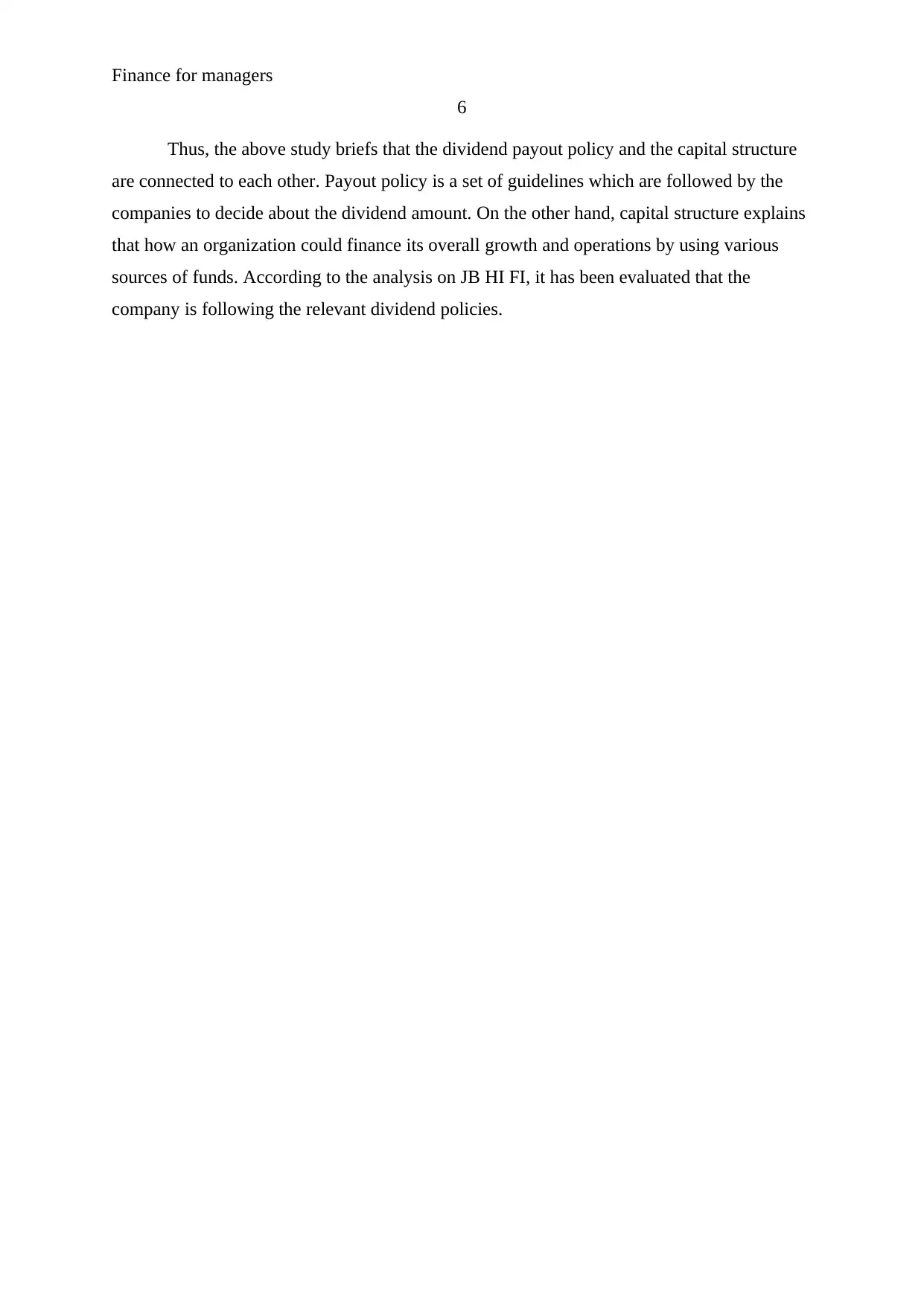
Finance for managers
6
Thus, the above study briefs that the dividend payout policy and the capital structure
are connected to each other. Payout policy is a set of guidelines which are followed by the
companies to decide about the dividend amount. On the other hand, capital structure explains
that how an organization could finance its overall growth and operations by using various
sources of funds. According to the analysis on JB HI FI, it has been evaluated that the
company is following the relevant dividend policies.
6
Thus, the above study briefs that the dividend payout policy and the capital structure
are connected to each other. Payout policy is a set of guidelines which are followed by the
companies to decide about the dividend amount. On the other hand, capital structure explains
that how an organization could finance its overall growth and operations by using various
sources of funds. According to the analysis on JB HI FI, it has been evaluated that the
company is following the relevant dividend policies.
⊘ This is a preview!⊘
Do you want full access?
Subscribe today to unlock all pages.

Trusted by 1+ million students worldwide
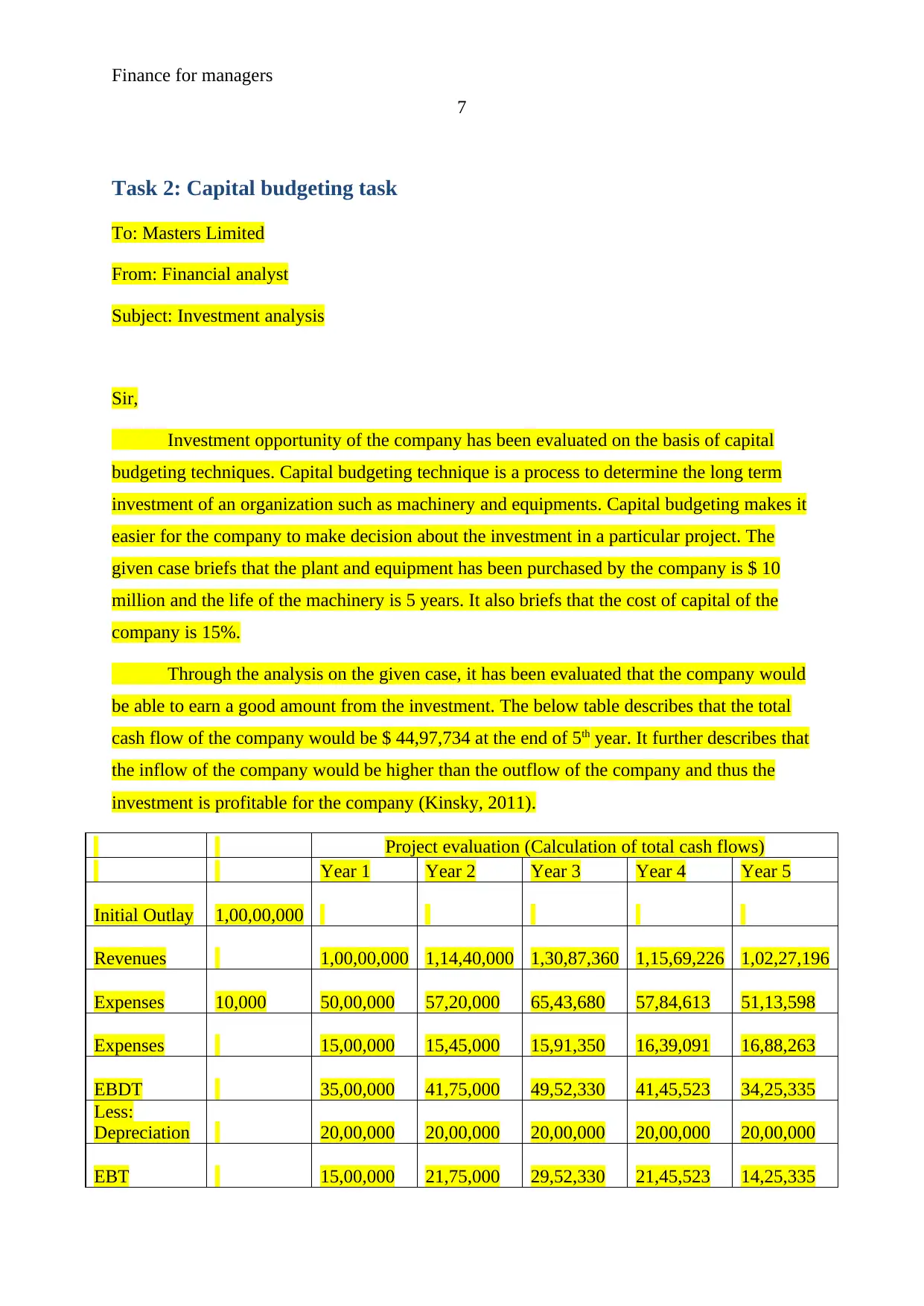
Finance for managers
7
Task 2: Capital budgeting task
To: Masters Limited
From: Financial analyst
Subject: Investment analysis
Sir,
Investment opportunity of the company has been evaluated on the basis of capital
budgeting techniques. Capital budgeting technique is a process to determine the long term
investment of an organization such as machinery and equipments. Capital budgeting makes it
easier for the company to make decision about the investment in a particular project. The
given case briefs that the plant and equipment has been purchased by the company is $ 10
million and the life of the machinery is 5 years. It also briefs that the cost of capital of the
company is 15%.
Through the analysis on the given case, it has been evaluated that the company would
be able to earn a good amount from the investment. The below table describes that the total
cash flow of the company would be $ 44,97,734 at the end of 5th year. It further describes that
the inflow of the company would be higher than the outflow of the company and thus the
investment is profitable for the company (Kinsky, 2011).
Project evaluation (Calculation of total cash flows)
Year 1 Year 2 Year 3 Year 4 Year 5
Initial Outlay 1,00,00,000
Revenues 1,00,00,000 1,14,40,000 1,30,87,360 1,15,69,226 1,02,27,196
Expenses 10,000 50,00,000 57,20,000 65,43,680 57,84,613 51,13,598
Expenses 15,00,000 15,45,000 15,91,350 16,39,091 16,88,263
EBDT 35,00,000 41,75,000 49,52,330 41,45,523 34,25,335
Less:
Depreciation 20,00,000 20,00,000 20,00,000 20,00,000 20,00,000
EBT 15,00,000 21,75,000 29,52,330 21,45,523 14,25,335
7
Task 2: Capital budgeting task
To: Masters Limited
From: Financial analyst
Subject: Investment analysis
Sir,
Investment opportunity of the company has been evaluated on the basis of capital
budgeting techniques. Capital budgeting technique is a process to determine the long term
investment of an organization such as machinery and equipments. Capital budgeting makes it
easier for the company to make decision about the investment in a particular project. The
given case briefs that the plant and equipment has been purchased by the company is $ 10
million and the life of the machinery is 5 years. It also briefs that the cost of capital of the
company is 15%.
Through the analysis on the given case, it has been evaluated that the company would
be able to earn a good amount from the investment. The below table describes that the total
cash flow of the company would be $ 44,97,734 at the end of 5th year. It further describes that
the inflow of the company would be higher than the outflow of the company and thus the
investment is profitable for the company (Kinsky, 2011).
Project evaluation (Calculation of total cash flows)
Year 1 Year 2 Year 3 Year 4 Year 5
Initial Outlay 1,00,00,000
Revenues 1,00,00,000 1,14,40,000 1,30,87,360 1,15,69,226 1,02,27,196
Expenses 10,000 50,00,000 57,20,000 65,43,680 57,84,613 51,13,598
Expenses 15,00,000 15,45,000 15,91,350 16,39,091 16,88,263
EBDT 35,00,000 41,75,000 49,52,330 41,45,523 34,25,335
Less:
Depreciation 20,00,000 20,00,000 20,00,000 20,00,000 20,00,000
EBT 15,00,000 21,75,000 29,52,330 21,45,523 14,25,335
Paraphrase This Document
Need a fresh take? Get an instant paraphrase of this document with our AI Paraphraser
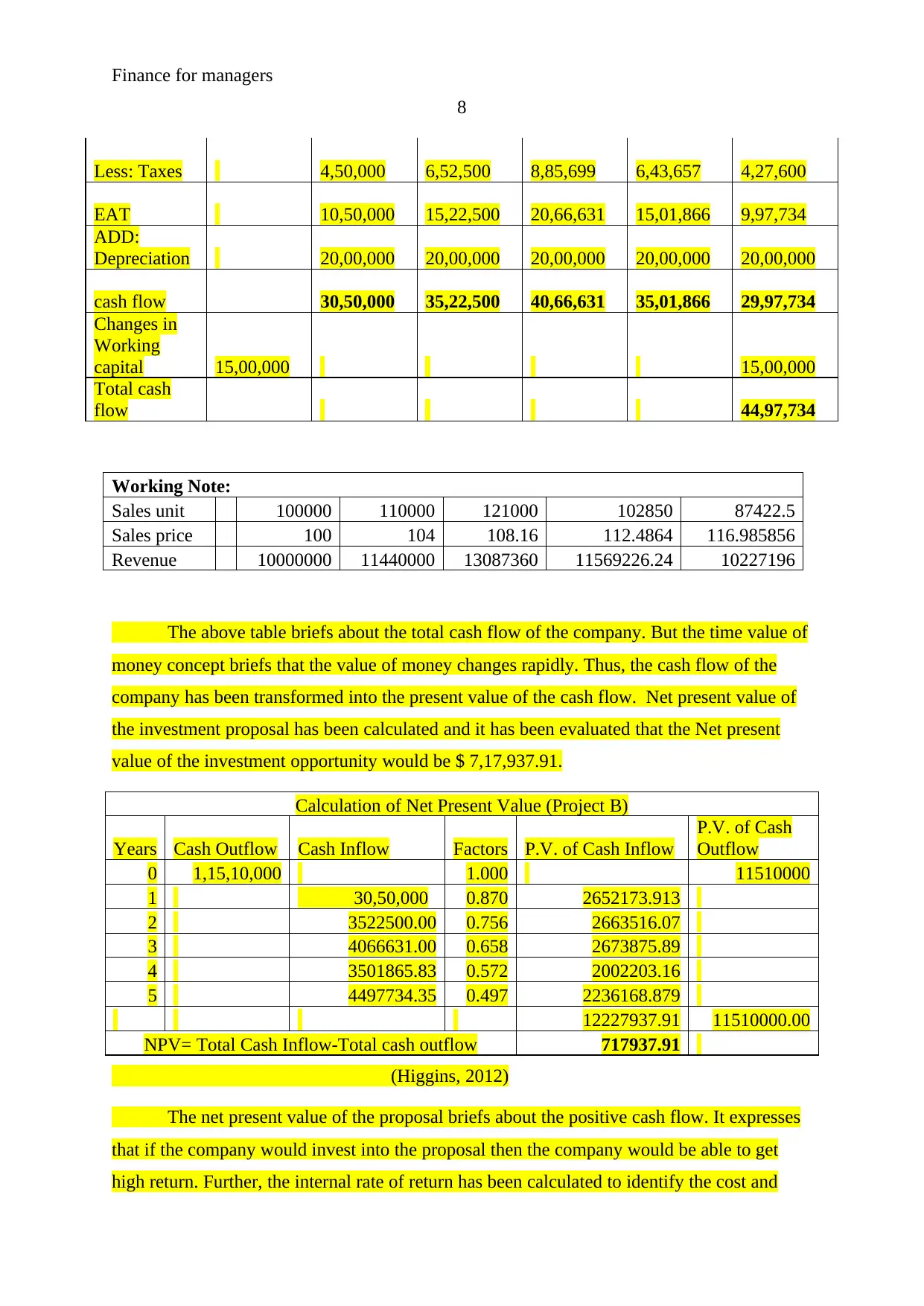
Finance for managers
8
Less: Taxes 4,50,000 6,52,500 8,85,699 6,43,657 4,27,600
EAT 10,50,000 15,22,500 20,66,631 15,01,866 9,97,734
ADD:
Depreciation 20,00,000 20,00,000 20,00,000 20,00,000 20,00,000
cash flow 30,50,000 35,22,500 40,66,631 35,01,866 29,97,734
Changes in
Working
capital 15,00,000 15,00,000
Total cash
flow 44,97,734
Working Note:
Sales unit 100000 110000 121000 102850 87422.5
Sales price 100 104 108.16 112.4864 116.985856
Revenue 10000000 11440000 13087360 11569226.24 10227196
The above table briefs about the total cash flow of the company. But the time value of
money concept briefs that the value of money changes rapidly. Thus, the cash flow of the
company has been transformed into the present value of the cash flow. Net present value of
the investment proposal has been calculated and it has been evaluated that the Net present
value of the investment opportunity would be $ 7,17,937.91.
Calculation of Net Present Value (Project B)
Years Cash Outflow Cash Inflow Factors P.V. of Cash Inflow
P.V. of Cash
Outflow
0 1,15,10,000 1.000 11510000
1 30,50,000 0.870 2652173.913
2 3522500.00 0.756 2663516.07
3 4066631.00 0.658 2673875.89
4 3501865.83 0.572 2002203.16
5 4497734.35 0.497 2236168.879
12227937.91 11510000.00
NPV= Total Cash Inflow-Total cash outflow 717937.91
(Higgins, 2012)
The net present value of the proposal briefs about the positive cash flow. It expresses
that if the company would invest into the proposal then the company would be able to get
high return. Further, the internal rate of return has been calculated to identify the cost and
8
Less: Taxes 4,50,000 6,52,500 8,85,699 6,43,657 4,27,600
EAT 10,50,000 15,22,500 20,66,631 15,01,866 9,97,734
ADD:
Depreciation 20,00,000 20,00,000 20,00,000 20,00,000 20,00,000
cash flow 30,50,000 35,22,500 40,66,631 35,01,866 29,97,734
Changes in
Working
capital 15,00,000 15,00,000
Total cash
flow 44,97,734
Working Note:
Sales unit 100000 110000 121000 102850 87422.5
Sales price 100 104 108.16 112.4864 116.985856
Revenue 10000000 11440000 13087360 11569226.24 10227196
The above table briefs about the total cash flow of the company. But the time value of
money concept briefs that the value of money changes rapidly. Thus, the cash flow of the
company has been transformed into the present value of the cash flow. Net present value of
the investment proposal has been calculated and it has been evaluated that the Net present
value of the investment opportunity would be $ 7,17,937.91.
Calculation of Net Present Value (Project B)
Years Cash Outflow Cash Inflow Factors P.V. of Cash Inflow
P.V. of Cash
Outflow
0 1,15,10,000 1.000 11510000
1 30,50,000 0.870 2652173.913
2 3522500.00 0.756 2663516.07
3 4066631.00 0.658 2673875.89
4 3501865.83 0.572 2002203.16
5 4497734.35 0.497 2236168.879
12227937.91 11510000.00
NPV= Total Cash Inflow-Total cash outflow 717937.91
(Higgins, 2012)
The net present value of the proposal briefs about the positive cash flow. It expresses
that if the company would invest into the proposal then the company would be able to get
high return. Further, the internal rate of return has been calculated to identify the cost and
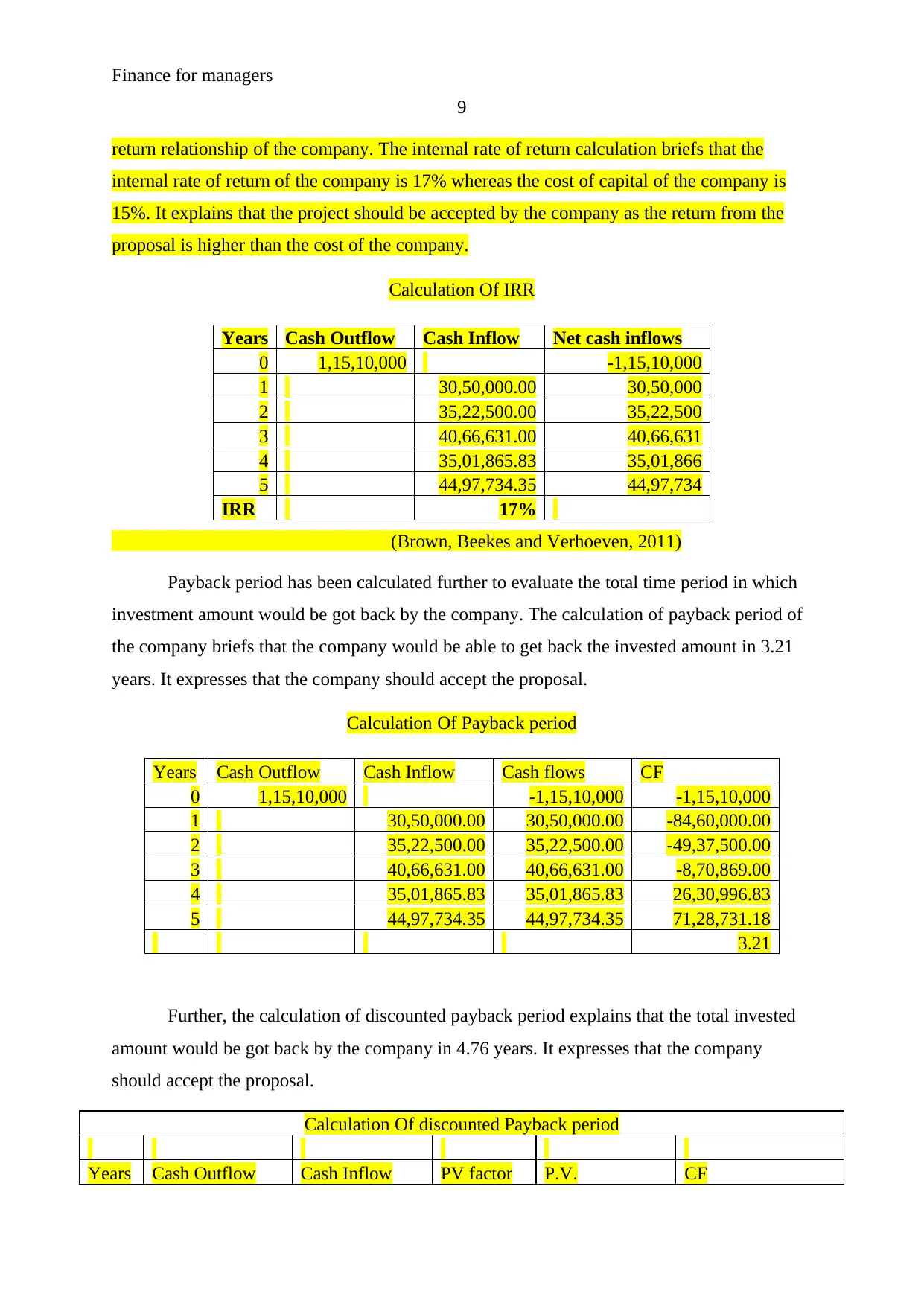
Finance for managers
9
return relationship of the company. The internal rate of return calculation briefs that the
internal rate of return of the company is 17% whereas the cost of capital of the company is
15%. It explains that the project should be accepted by the company as the return from the
proposal is higher than the cost of the company.
Calculation Of IRR
Years Cash Outflow Cash Inflow Net cash inflows
0 1,15,10,000 -1,15,10,000
1 30,50,000.00 30,50,000
2 35,22,500.00 35,22,500
3 40,66,631.00 40,66,631
4 35,01,865.83 35,01,866
5 44,97,734.35 44,97,734
IRR 17%
(Brown, Beekes and Verhoeven, 2011)
Payback period has been calculated further to evaluate the total time period in which
investment amount would be got back by the company. The calculation of payback period of
the company briefs that the company would be able to get back the invested amount in 3.21
years. It expresses that the company should accept the proposal.
Calculation Of Payback period
Years Cash Outflow Cash Inflow Cash flows CF
0 1,15,10,000 -1,15,10,000 -1,15,10,000
1 30,50,000.00 30,50,000.00 -84,60,000.00
2 35,22,500.00 35,22,500.00 -49,37,500.00
3 40,66,631.00 40,66,631.00 -8,70,869.00
4 35,01,865.83 35,01,865.83 26,30,996.83
5 44,97,734.35 44,97,734.35 71,28,731.18
3.21
Further, the calculation of discounted payback period explains that the total invested
amount would be got back by the company in 4.76 years. It expresses that the company
should accept the proposal.
Calculation Of discounted Payback period
Years Cash Outflow Cash Inflow PV factor P.V. CF
9
return relationship of the company. The internal rate of return calculation briefs that the
internal rate of return of the company is 17% whereas the cost of capital of the company is
15%. It explains that the project should be accepted by the company as the return from the
proposal is higher than the cost of the company.
Calculation Of IRR
Years Cash Outflow Cash Inflow Net cash inflows
0 1,15,10,000 -1,15,10,000
1 30,50,000.00 30,50,000
2 35,22,500.00 35,22,500
3 40,66,631.00 40,66,631
4 35,01,865.83 35,01,866
5 44,97,734.35 44,97,734
IRR 17%
(Brown, Beekes and Verhoeven, 2011)
Payback period has been calculated further to evaluate the total time period in which
investment amount would be got back by the company. The calculation of payback period of
the company briefs that the company would be able to get back the invested amount in 3.21
years. It expresses that the company should accept the proposal.
Calculation Of Payback period
Years Cash Outflow Cash Inflow Cash flows CF
0 1,15,10,000 -1,15,10,000 -1,15,10,000
1 30,50,000.00 30,50,000.00 -84,60,000.00
2 35,22,500.00 35,22,500.00 -49,37,500.00
3 40,66,631.00 40,66,631.00 -8,70,869.00
4 35,01,865.83 35,01,865.83 26,30,996.83
5 44,97,734.35 44,97,734.35 71,28,731.18
3.21
Further, the calculation of discounted payback period explains that the total invested
amount would be got back by the company in 4.76 years. It expresses that the company
should accept the proposal.
Calculation Of discounted Payback period
Years Cash Outflow Cash Inflow PV factor P.V. CF
⊘ This is a preview!⊘
Do you want full access?
Subscribe today to unlock all pages.

Trusted by 1+ million students worldwide
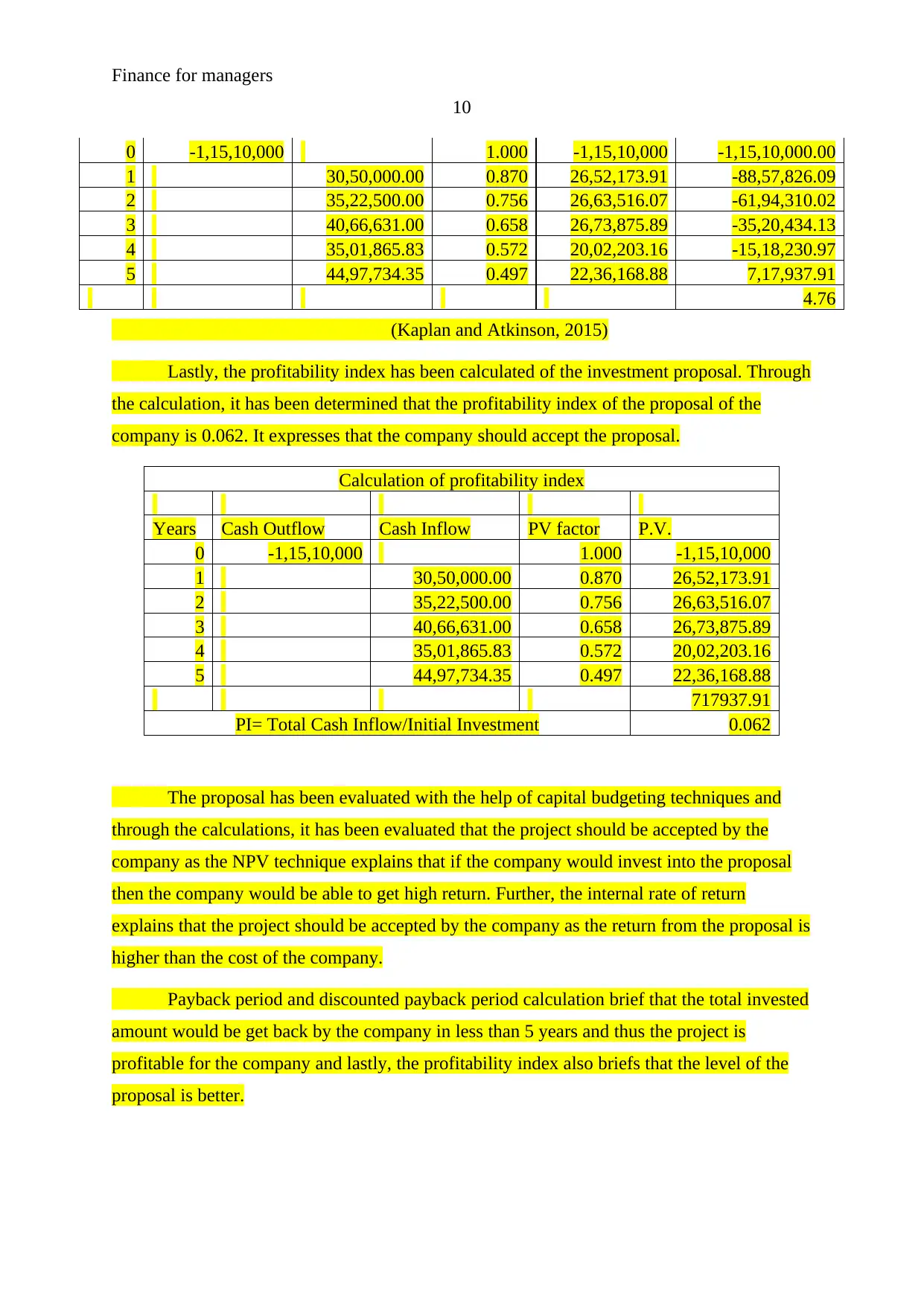
Finance for managers
10
0 -1,15,10,000 1.000 -1,15,10,000 -1,15,10,000.00
1 30,50,000.00 0.870 26,52,173.91 -88,57,826.09
2 35,22,500.00 0.756 26,63,516.07 -61,94,310.02
3 40,66,631.00 0.658 26,73,875.89 -35,20,434.13
4 35,01,865.83 0.572 20,02,203.16 -15,18,230.97
5 44,97,734.35 0.497 22,36,168.88 7,17,937.91
4.76
(Kaplan and Atkinson, 2015)
Lastly, the profitability index has been calculated of the investment proposal. Through
the calculation, it has been determined that the profitability index of the proposal of the
company is 0.062. It expresses that the company should accept the proposal.
Calculation of profitability index
Years Cash Outflow Cash Inflow PV factor P.V.
0 -1,15,10,000 1.000 -1,15,10,000
1 30,50,000.00 0.870 26,52,173.91
2 35,22,500.00 0.756 26,63,516.07
3 40,66,631.00 0.658 26,73,875.89
4 35,01,865.83 0.572 20,02,203.16
5 44,97,734.35 0.497 22,36,168.88
717937.91
PI= Total Cash Inflow/Initial Investment 0.062
The proposal has been evaluated with the help of capital budgeting techniques and
through the calculations, it has been evaluated that the project should be accepted by the
company as the NPV technique explains that if the company would invest into the proposal
then the company would be able to get high return. Further, the internal rate of return
explains that the project should be accepted by the company as the return from the proposal is
higher than the cost of the company.
Payback period and discounted payback period calculation brief that the total invested
amount would be get back by the company in less than 5 years and thus the project is
profitable for the company and lastly, the profitability index also briefs that the level of the
proposal is better.
10
0 -1,15,10,000 1.000 -1,15,10,000 -1,15,10,000.00
1 30,50,000.00 0.870 26,52,173.91 -88,57,826.09
2 35,22,500.00 0.756 26,63,516.07 -61,94,310.02
3 40,66,631.00 0.658 26,73,875.89 -35,20,434.13
4 35,01,865.83 0.572 20,02,203.16 -15,18,230.97
5 44,97,734.35 0.497 22,36,168.88 7,17,937.91
4.76
(Kaplan and Atkinson, 2015)
Lastly, the profitability index has been calculated of the investment proposal. Through
the calculation, it has been determined that the profitability index of the proposal of the
company is 0.062. It expresses that the company should accept the proposal.
Calculation of profitability index
Years Cash Outflow Cash Inflow PV factor P.V.
0 -1,15,10,000 1.000 -1,15,10,000
1 30,50,000.00 0.870 26,52,173.91
2 35,22,500.00 0.756 26,63,516.07
3 40,66,631.00 0.658 26,73,875.89
4 35,01,865.83 0.572 20,02,203.16
5 44,97,734.35 0.497 22,36,168.88
717937.91
PI= Total Cash Inflow/Initial Investment 0.062
The proposal has been evaluated with the help of capital budgeting techniques and
through the calculations, it has been evaluated that the project should be accepted by the
company as the NPV technique explains that if the company would invest into the proposal
then the company would be able to get high return. Further, the internal rate of return
explains that the project should be accepted by the company as the return from the proposal is
higher than the cost of the company.
Payback period and discounted payback period calculation brief that the total invested
amount would be get back by the company in less than 5 years and thus the project is
profitable for the company and lastly, the profitability index also briefs that the level of the
proposal is better.
Paraphrase This Document
Need a fresh take? Get an instant paraphrase of this document with our AI Paraphraser
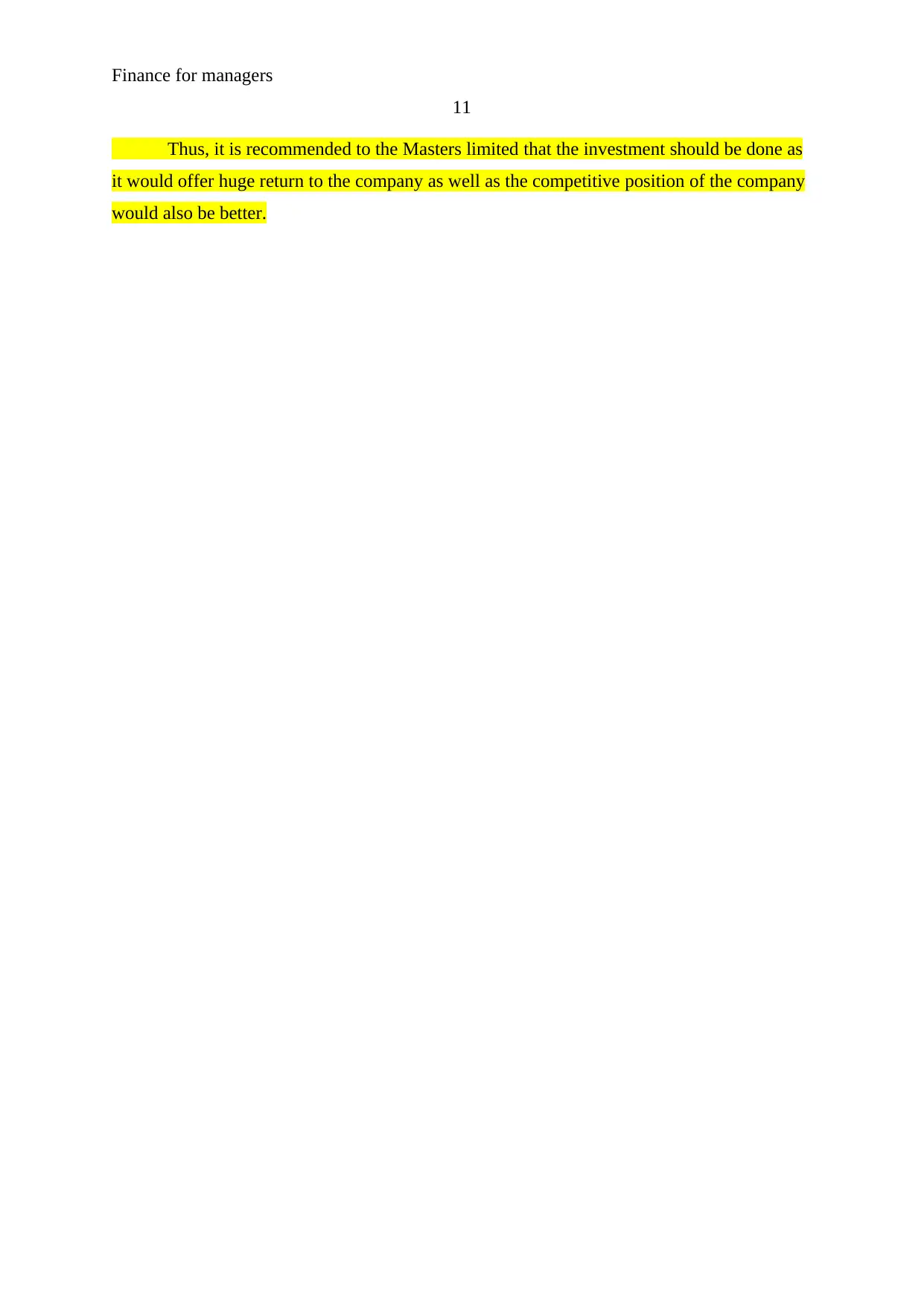
Finance for managers
11
Thus, it is recommended to the Masters limited that the investment should be done as
it would offer huge return to the company as well as the competitive position of the company
would also be better.
11
Thus, it is recommended to the Masters limited that the investment should be done as
it would offer huge return to the company as well as the competitive position of the company
would also be better.
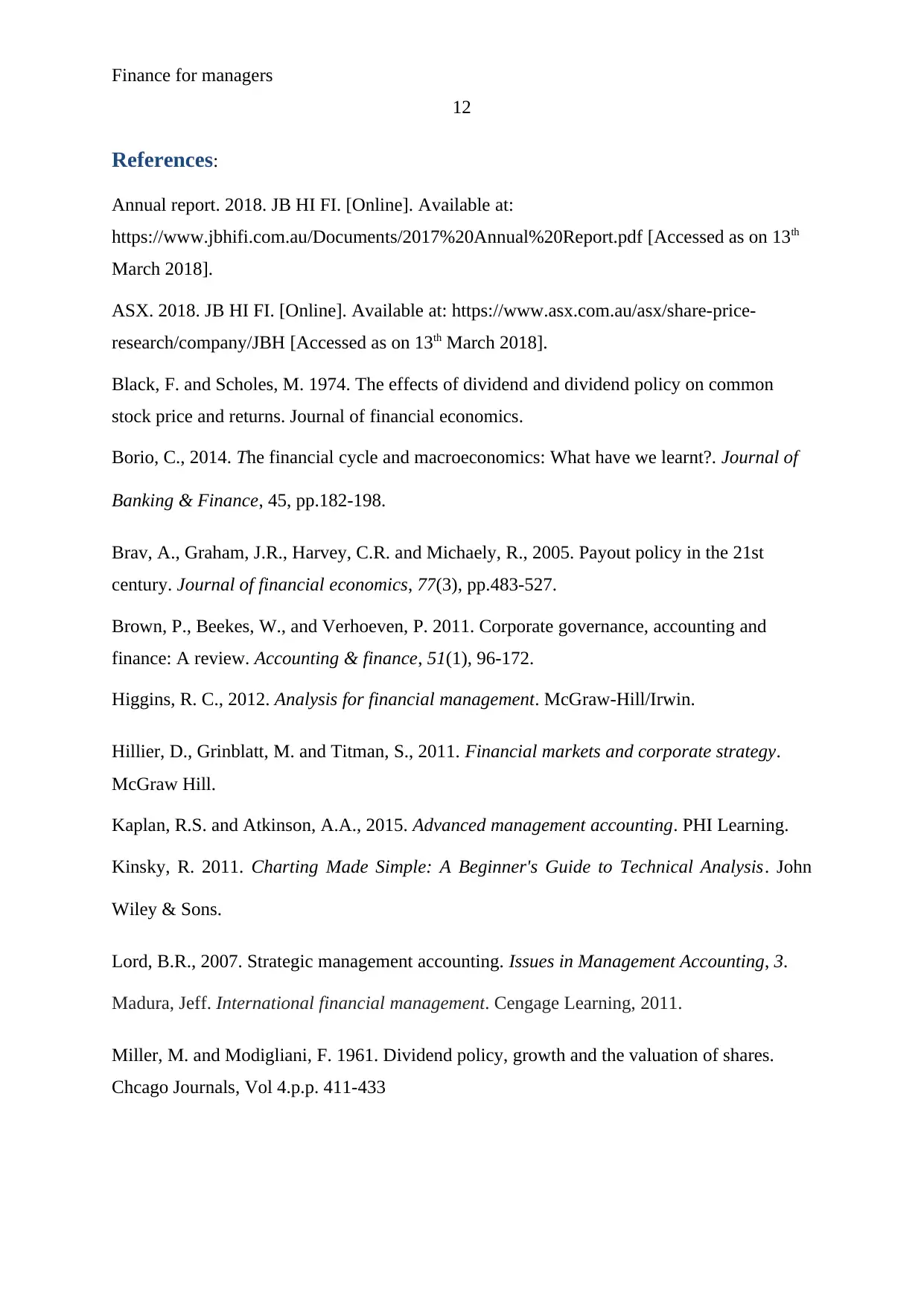
Finance for managers
12
References:
Annual report. 2018. JB HI FI. [Online]. Available at:
https://www.jbhifi.com.au/Documents/2017%20Annual%20Report.pdf [Accessed as on 13th
March 2018].
ASX. 2018. JB HI FI. [Online]. Available at: https://www.asx.com.au/asx/share-price-
research/company/JBH [Accessed as on 13th March 2018].
Black, F. and Scholes, M. 1974. The effects of dividend and dividend policy on common
stock price and returns. Journal of financial economics.
Borio, C., 2014. The financial cycle and macroeconomics: What have we learnt?. Journal of
Banking & Finance, 45, pp.182-198.
Brav, A., Graham, J.R., Harvey, C.R. and Michaely, R., 2005. Payout policy in the 21st
century. Journal of financial economics, 77(3), pp.483-527.
Brown, P., Beekes, W., and Verhoeven, P. 2011. Corporate governance, accounting and
finance: A review. Accounting & finance, 51(1), 96-172.
Higgins, R. C., 2012. Analysis for financial management. McGraw-Hill/Irwin.
Hillier, D., Grinblatt, M. and Titman, S., 2011. Financial markets and corporate strategy.
McGraw Hill.
Kaplan, R.S. and Atkinson, A.A., 2015. Advanced management accounting. PHI Learning.
Kinsky, R. 2011. Charting Made Simple: A Beginner's Guide to Technical Analysis. John
Wiley & Sons.
Lord, B.R., 2007. Strategic management accounting. Issues in Management Accounting, 3.
Madura, Jeff. International financial management. Cengage Learning, 2011.
Miller, M. and Modigliani, F. 1961. Dividend policy, growth and the valuation of shares.
Chcago Journals, Vol 4.p.p. 411-433
12
References:
Annual report. 2018. JB HI FI. [Online]. Available at:
https://www.jbhifi.com.au/Documents/2017%20Annual%20Report.pdf [Accessed as on 13th
March 2018].
ASX. 2018. JB HI FI. [Online]. Available at: https://www.asx.com.au/asx/share-price-
research/company/JBH [Accessed as on 13th March 2018].
Black, F. and Scholes, M. 1974. The effects of dividend and dividend policy on common
stock price and returns. Journal of financial economics.
Borio, C., 2014. The financial cycle and macroeconomics: What have we learnt?. Journal of
Banking & Finance, 45, pp.182-198.
Brav, A., Graham, J.R., Harvey, C.R. and Michaely, R., 2005. Payout policy in the 21st
century. Journal of financial economics, 77(3), pp.483-527.
Brown, P., Beekes, W., and Verhoeven, P. 2011. Corporate governance, accounting and
finance: A review. Accounting & finance, 51(1), 96-172.
Higgins, R. C., 2012. Analysis for financial management. McGraw-Hill/Irwin.
Hillier, D., Grinblatt, M. and Titman, S., 2011. Financial markets and corporate strategy.
McGraw Hill.
Kaplan, R.S. and Atkinson, A.A., 2015. Advanced management accounting. PHI Learning.
Kinsky, R. 2011. Charting Made Simple: A Beginner's Guide to Technical Analysis. John
Wiley & Sons.
Lord, B.R., 2007. Strategic management accounting. Issues in Management Accounting, 3.
Madura, Jeff. International financial management. Cengage Learning, 2011.
Miller, M. and Modigliani, F. 1961. Dividend policy, growth and the valuation of shares.
Chcago Journals, Vol 4.p.p. 411-433
⊘ This is a preview!⊘
Do you want full access?
Subscribe today to unlock all pages.

Trusted by 1+ million students worldwide
1 out of 12
Related Documents
Your All-in-One AI-Powered Toolkit for Academic Success.
+13062052269
info@desklib.com
Available 24*7 on WhatsApp / Email
![[object Object]](/_next/static/media/star-bottom.7253800d.svg)
Unlock your academic potential
Copyright © 2020–2025 A2Z Services. All Rights Reserved. Developed and managed by ZUCOL.




